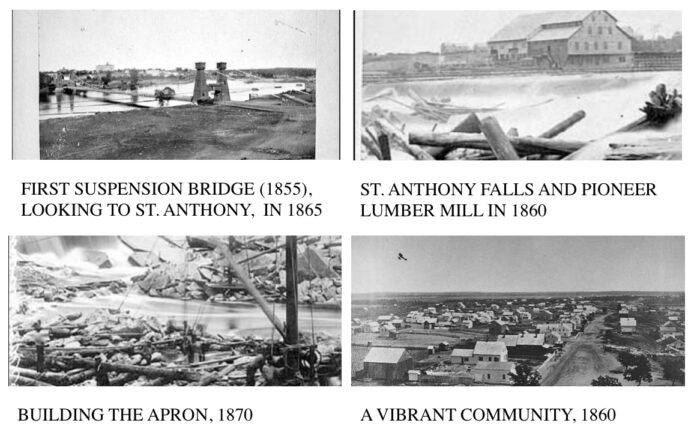Captain Michael Hoy served on the department at a time of great growth and transformation, including the incorporation of the separate cities of St. Anthony and Minneapolis into one larger Minneapolis.
We know that the majority of crimes charged in the St. Anthony of Captain Hoy’s time were for minor offenses such as public drunkeness, fighting, and solicitation and were mostly committed by lumbermen coming in from the woods to St. Anthony.
We know from the book “History of the Police and Fire Departments of the Twin Cities: Their Origin in Early Village Days and Progress to 1900” (published in 1899) that when Captain Hoy locked up and left the City Jail each night he did not know if the prisoners would still be there when he returned the next morning. Sometimes, the prisoners would dig themselves out of the jail and flee the city. After a number of such occurrences, the city appointed L.C. Smith as Assistant City Marshal to help Captain Hoy and overnight escapes became rare.
Here is a snapshot of St. Anthony as Captain Hoy would have known it:
A Vibrant Residential and Business District
The first building boom in Minneapolis and St. Anthony extended from 1854 to the Panic of 1857. A number of “elegant private residences” were reported on both sides of the river, along with 42 business places, and a variety of physicians and attorney’s offices, and several hotels and boarding houses. Many of the houses of this period were of Greek Revival style, with low-pitched gable roofs and resting on limestone foundations quarried from nearby ledges. Millwork trim was applied to the windows and entries, and sidelights and a glazed transom framed the entry of some. Two Greek Revival houses from the pre-1857 period survive, but not in their original locations. The Ard Godfrey House (1849), is now in Chute Square, and the John H. Stevens House (1849), is now in Minnehaha Park.
1862 First Railroad
The Minnesota and Pacific Railroad was the first to reach St. Anthony Falls. On June 28, 1862, the locomotive Wm. Crooks led cars carrying about 100 passengers along ten miles of track built from St. Paul. Until this date, only poor roads and the river brought settlers and freight to the falls. The first depot was built at Main Street and East Hennepin Avenue. The Minnesota Central Railroad Company was the next to operate from the vicinity of the falls, and eventually provided a connection from the west side of the river to Chicago. Construction began in 1863, and followed a southerly route to Mendota along present-day Minnehaha Avenue, which was the territorial road to Fort Snelling. The first railroad bridge linking the east and west riverbanks was completed in 1867. Railroad construction surged after the Civil War with the opening of grain markets to the west. Captain Hoy would not have been surprised to learn that by 1910, the lines of eleven railroad companies crossed Minneapolis.
1865 First Telegraph
The Northwestern Telegraph Company opened an office over Baldwin’s Bank in Bridge Square and offered the first telegraph service on one line extending from St. Paul to Faribault via Minneapolis. By 1886, Western Union and the North American Telegraph Company, a local firm, also offered service.
1870 Construction of Wood Apron
On October 5, 1869, the Eastman Tunnel under construction between Nicollet and Hennepin Islands collapsed. The already fragile soft sandstone below the thin limestone ledge was undermined by tunnel construction as well as natural erosion. The cataclysmic event threatened St. Anthony Falls and brought great fear for the future of Minneapolis. One observer wrote, “Men saw in imagination a ruined water power, crushed hopes, the loss of large investments, and a deserted city.” The first full-length wood apron was constructed over St. Anthony Falls by the US Army Corps of Engineers in 1870 to prevent further erosion of the thin layer of limestone and the city continued to grow.
Photographs and event highlights courtesy of “The Minneapolis Riverfront as Birth Place and First Place” which was prepared in 2008 for The Saint Anthony Falls Heritage Board by MinnesotaLandscape Research LLC.
